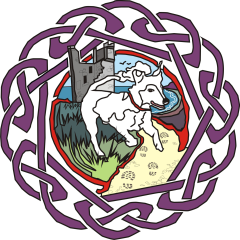Bewick Moor – a prehistoric landscape deep in rural Northumberland

Bewick Moor is a hidden gem, lying between Northumberland National Park and the Northumberland Coast, it is a huge area of upland raised bog, covered largely in heather, grazed by a few sheep and packed with prehistoric features, just waiting to be discovered. The walk starts in the village of Eglingham, there’s a reason for that, there’s a pub and it’s a great place to finish the walk, but I’m getting ahead of myself, there’s a walk to do first. It’s a bit of an uphill slog to reach the open moorland, but once you do, there are glimpses of the Cheviot Hills and the Coast, a taste of things to come. Cateran Hill is the highest point of the moor and just beyond that is Cateran Hole, a deep, dark and mysterious cave descending beneath the surface and well worth entering into, to experience the darkness and to see the lichen/algae that glistens like specks of gold on the damp surfaces of the cave walls. The cave is a tricky thing to find, but there is a clue, you just need to know where to look to find it.
After the cave, the walk continues along easy to follow moorland bridleways. Sundew, an insectivirous plant grows in the damp ditches, although not there in February, it will soon be emerging from its winter dormancy to trap and absorb tiny insects and store up energy for another year.
Arriving at Blawearie, a remote and ruined farm steading high on the moor has it’s fair to say, a touch of the Wuthering Heights about it, abandoned for almost 60-years, it’s slowly returning to the earth, tumbling down around us. It is fun to explore though, trying to work out which building was used for what purpose and just what was it like to have lived and farmed up here on Bewick Moor.
The next stop is a reminder that people have been living on Bewick Moor for thousands of years, a Bronze Age burial cairn, complete with ‘Cist’ chambers and enclosure stones is certainly my favourite prehistoric monument in Northumberland. Further up the hill, a huge boulder carved with those curious ‘cup and ring’ rock art symbols generated plenty of discussion. Their purpose will remain a curiosity, although it is always interesting to share thoughts and ideas on what are perhaps the most ancient reminders of Northumberland’s prehistoric past.
Bewick Moor has three hillfort sites and we visited one of these high on Bewick Hill. It is some location, a classic double rampart and ditch surrounds the fort and to the south, the land drops dramatically away down to the valley floor. Roman Legionaries following the Devil’s Causeway, the old Roman Road, would have no doubt have looked up at the hillforts as they passed by below.
From the hillforts on Bewick Hill, the walk takes in two further oddities, an incomplete millstone perches on a plinth, never finished, another reminder of a past industrial landscape. There are other unfinished millstones that I know of in Northumberland, but this is the best of them. Perhaps the most curious thing is what can be best described as a bath, carved into and out of a sandstone block, it sits in splendid isolation on the hillside. Again, lots of discussion about its purpose and its age, all quite plausible, but it remains a mystery and I like that. If you want to see it, then join a Footsteps guided walk across the fabulous Bewick Moor, you might just have the answer.
Finally, arriving back in Eglingham, the Tankerville Arms welcomed us and around the table, a moment to reflect and share memories about the remarkable prehistoric landscape that is Bewick Moor.
